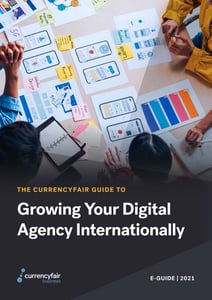Create the perfect pitch for winning new clients for your agency
As a digital marketing agency looking for new clients, your pitch is your most important tool. To win the business, it has to be good; better than the competition. Because when it comes to a pitch, even the smallest, or newest, agency can make a big impact. Which is why it’s so important to get it right.
Unfortunately, not everyone has a talented design team on-hand to create a beautifully branded deck, especially if you’re small, or just established. So here’s what you need to know to create the perfect pitch to win over your next client.
The pitch deck
At the heart of every sales pitch is your pitch deck - essentially, a presentation for prospective clients that tells them who you are, what you do, and most importantly, why they should give you their business. There are many tools out there to help you create your pitch deck. Which you choose will depend on the software already in use in your organisation, as well as your individual needs.
Microsoft PowerPoint - The standard when it comes to presentations and still very popular today.
Google Slides - Much like a simplified version of PowerPoint - good for collaborative efforts.
Keynote for Mac - Elegant and easy-to-use interface, allowing documents to be easily converted to PowerPoint.
Visme - Designed for non-designers with a big range of images, icons, backgrounds and templates.
Prezi - PC World regards Prezi as one of the best presentation tools out there for collaborative brainstorming.
Canva - Comes with a range of attractive templates that you can customise depending on your needs. However, Canva does tend to create big files, which can be problematic for sharing.
SalesHandy - If you regularly send out pitch decks, SalesHandy comes with a number of reporting capabilities that tracks what happens when and where it’s opened.
Know your prospect
Of course, the same deck won’t meet the needs of every sales pitch. While you should be able to keep certain core elements of your deck, the pitch will need to be adapted for each client to optimise your chances of success. That means investing in some hefty groundwork beforehand in order to understand the client’s business model, customer base and unique needs:
- Client offerings and positioning.
- Customer demographic.
- Challenges faced by the brand and how you can solve them.
- Key personnel at the company.
- Extent of their knowledge of what you do.
- Budget.
Once you have this information you can personalise your pitch deck for greater effectiveness. For instance, if you know they’re already using some basic digital marketing in-house, let them know how you can improve its effectiveness or supplement it with another service. Likewise, when you know their budget, you’ll know what you can offer to match what they have to spend, or suggest ways in which that budget can be utilised more effectively.
The most obvious way to get this information is to request a discovery session, where you can ask questions and gain the insights you need to fill out your pitch deck. The more you can find out - the better. Include some quirky questions that may reveal something you can use that your competitors won’t have access to. For instance, does the client have a favourite type of pizza? If so, you can bring some along for a post-pitch treat. You might even be able to build an interesting angle into your pitch, such as comparing toppings to the services you provide.
While a Google search will tell you a lot about your potential client, there are other Google tools that can help too when it comes to researching prospects. Google Search Console is completely free and can tell you a lot about your client’s online presence, delivering insights you can use to pitch your services more persuasively.
If you’re willing to pay, SEMrush can give you a more in-depth understanding of the issues facing your client. Tools such as domain overview, site audit, or a competitor analysis, can reveal where their current marketing efforts may be falling down. You can then include ways of fixing those failings, or supplementing their efforts in your presentation.
What to include in your presentation
Larger, more established digital marketing agencies will have their own design teams in-house that can create a branded template that you can then fill in, but if you don’t have those resources, it could be a good investment to pay a freelance designer for a high quality template you can adapt for each pitch. Alternatively, there are a number of online resources, such as Hubspot, that have free templates, created by professional designers, that you customise for your needs.
Make sure your presentation is attractive and consistent in terms of design, colours and imagery. It should be easy to read with a voice and style that matches your brand identity. It can be tempting to use too many slides, but some of the most successful pitches happen in 15 slides or less. If, when you’re finished putting your deck together, you have more than that, have a thorough review. Be ruthless and strip out anything that isn’t needed to keep it relevant, uncluttered and interesting. Instead, use plenty of visuals. These assist with understanding and recall.
The founders of social media tool brand, Buffer, used just 13 slides to land US$500,000 in three months.
After the cover page with the name of your business and logo, your first page should directly highlight your competitive advantage, or unique selling point (USP). What is it that you do differently or better than your competitors? Get together with your team and brainstorm this as a single headline or soundbite. This should encapsulate how your USP translates into a solution for your prospect.
The next page should sum up the problem you’re trying to solve for your client. Start with a short headline with three or more single line benefits that you can expand on during the presentation.
Introduce the key players on the team, especially those that the client will be in contact with. Highlight what they bring to your efforts (not what they did at high school). If key personnel aren’t with you, use quality shots of team members to demonstrate professionalism and elicit trust.
Present a potential strategy for the solutions you offer, however, leave it open-ended, so that they can weigh in and customise points if need be. By all means be open to suggestions. Your goal is to get the business. The finer details can be discussed later.
Clearly outline your strategy, pricing model, and what they’ll get for their money in terms of services, deliverables and resources. Follow up with how you will quantify your results. During your discovery session, you should inquire about KPIs the business would like to see. Once you know what they are, you can identify the tools you need to measure the success of your efforts and put in place a reporting mechanism that suits the needs of the company.
Detail how their budget will be spent, highlighting how cost-effective your agency will be due to the added value you can bring to the table. Throughout, demonstrate clearly that you understand their needs and have the capabilities to address their pain points.
After that, demonstrate how you delivered great outcomes for other clients using case studies - ideally from the same industry sector.
It can be beneficial to outline potential risks, especially if clients appear unaware of them. Just make sure you have the answers when it comes to tackling those issues. It shows that you’re thinking ahead and have contingencies in place.
Delivering the goods
On the day, don’t waste your prospect’s time with lengthy preambles. They may have already sat through a few pitches before yours and could be pitch-weary, or this might be the start of a long day of sales pitches. In which case, you may be viewed more favourably by being succinct and to the point.
Before a brief overview of your proposition, be creative and think of something that makes them sit up and take notice, such as something that’s trending in their industry, a shocking statistic, or an unexpected visual. Alternatively, this might be where you reveal the pizza we discussed earlier. The point is to make an immediate, memorable, impact. Above all, avoid clichés in your opening statement.
Remember that you’re talking to human beings. Try not to sound like on autopilot, even if you’ve rehearsed so much you know your patter off by heart. Make eye contact and respond to body language/facial expressions. If someone looks surprised by a fact or statistic you mention, acknowledge them with a nod, further explanation, or a statement such as: “Surprising, isn’t it?”
It can be a good idea to offer sound advice outside the remit of the services offer. Little details can make a big difference. For example, if your client has operations overseas, let them know that working with a partner such as CurrencyFair, you have the tools to deal with foreign transactions, much more cheaply and efficiently than traditional banks. Benefits such as same day money transfers with no hidden fees might seem minor in the context of the pitch, but, in a split decision, could be enough to win you the business.
At the same time, know when to stop. A good salesperson knows when they’ve hit a home run. If you hear a yes, that’s when you stop pitching, even if you haven’t finished. You’re just as likely to produce a negative response if you continue.
End by summarising the main points and highlighting the benefits for choosing your marketing agency over others. Make sure your differentiators are clearly stated.
You’ll have a certain timeframe to deliver your pitch. Don’t go over your allocated time and leave room at the end to take questions. It’s easy to anticipate common objections such as budget constraints, so make a list of possible questions and rehearse well-reasoned answers.
Often, it’s a good idea to finish your presentations with a question, as this can avoid awkward silences and direct the flow of conversation towards a topic or question that you can handle confidently. A good example here is: “So what would you like us to focus on first?”
Over to you
It’s not easy getting a sales lead to the point where you have been offered a chance to pitch so it’s vital to make the most of it.
Many deals are closed in the follow-up, so have a mechanism in place for what happens next. Send an email to thank your prospective client for the opportunity to show what your agency can do, communicating your availability and willingness for a follow-up conversation, if necessary, and request a timeline for a decision
Presentations are never easy, especially when you’re pitching for new business. And every sales pitch is different, but most come down to a combination of solid research, well-designed content and great delivery. Get those right and you’ll see the rewards in more business.
Sources:
https://www.pcworld.com/article/233765/prezi.html
4 myths about UK students studying abroad
How to transfer money abroad from the UK
Related Articles
Search
Popular Posts
-
Currency symbols around the world
February 9, 2022 -
International Money Transfer Companies Compared: UK
December 11, 2019 -
#CommunityStory: Employment in a borderless world
December 11, 2017



